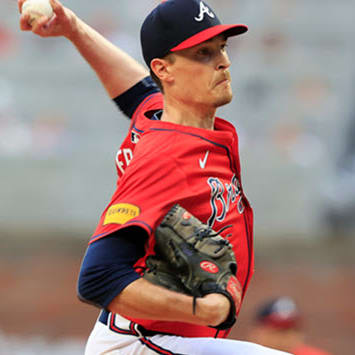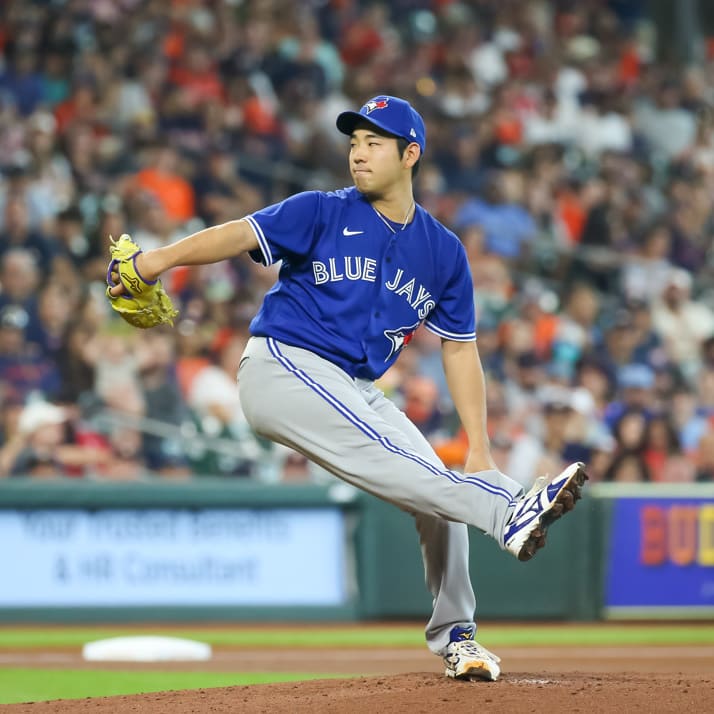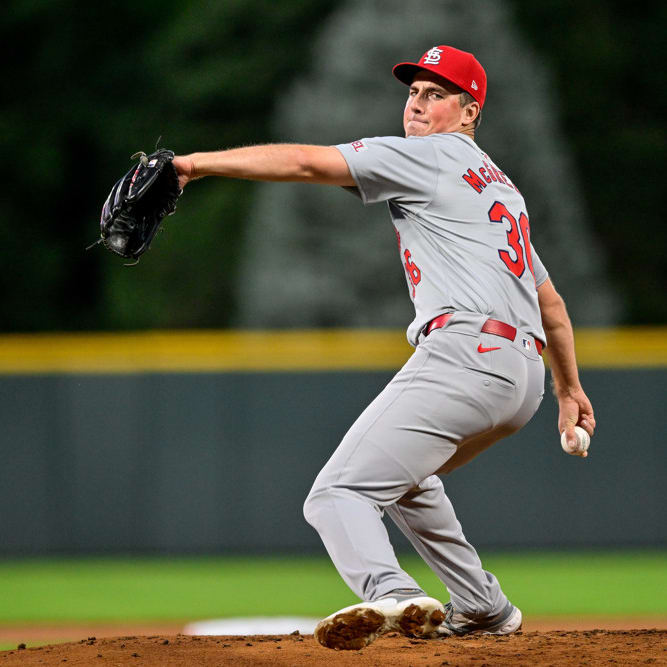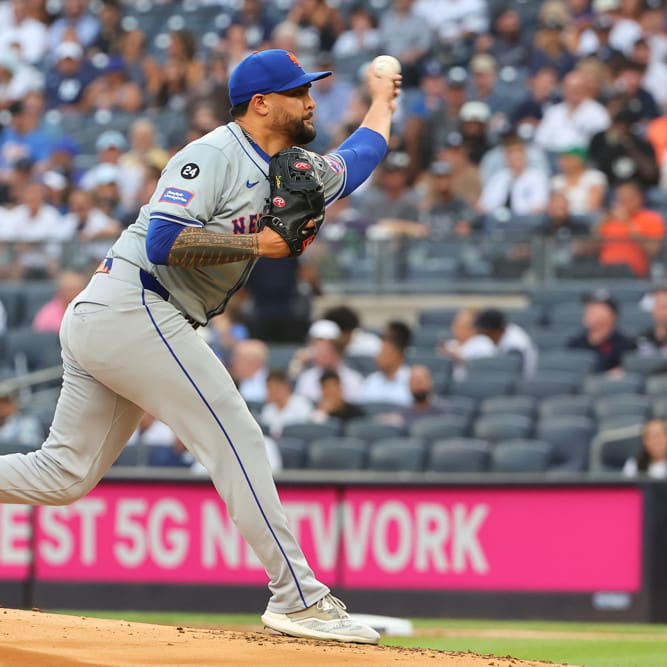This article is part of our Collette Calls series.
I'm getting an early start to these for the 2020 season, much like the free agency market was well ahead of the Winter Meetings this winter. I didn't publish the first of this series in 2018 until early February, and this past season, the first one went up at the end of January. My silence of late has been due to my focused efforts on doing more work than ever for the RotoWire draft magazine, but my work there is done and now my writing is focused on this column, and in particular, this annual series.
Each of the past two seasons, I've hit on 24 of the 60 bold predictions I made that preseason. The 2018 results can be seen by clicking here, but last year's results are tabled below:

I was more accurate in the American League last season, but those numbers were flipped the season before.
The premise for bold predictions remains the same: they need to be grounded in some form of reality. When I am looking at the numbers behind bold predictions, I am looking at something that is in the 10-20 percent area of likely outcomes for that batter or pitcher. They've either had to do the performance before, or have the hidden metrics in their profile that point to something good or bad about to come. I'm not going out there predicting the Cy Young for Lance Lynn or Jake Odorizzi, but you bet I was smiling each time those guys took the mound and dealt last year. Both of those pitchers were pitchers I wrote up in the Value in the Scrap Heap article and included them in my bold predictions. Unfortunately, I did not end up with enough shares of them as my leaguemates knew of my adoration of each guy at the auction table.
The 2019 series began with the National League as I did better in those predictions, so the 2020 series begins in the American League for the same reason. Traditionally, this has been an east-to-west adventure, so I'll change that up and tell the east coast bias to go run laps.
Houston
I refuse to go the easy route here and predict hitting regression because the sign stealing process has been exposed.
Myles Straw is a top 25 shortstop. There have been 25 Draft Champion drafts at NFBC to date, and Straw is currently 49th at the shortstop position with an ADP of 595, never going earlier than pick 515.
Tim Locastro was the only player in MLB in 2019 who had a faster sprint time from home to first than Straw. By average sprint speed, only Locastro, Trea Turner and Byron Buxton were faster in 2019. Straw can absolutely fly, and stole 70 bases in the minors between Double-A and Triple-A in 2018. Last year, he was 27 of 32 between Triple-A and the majors in 122 games. The last thing a pitcher wants to do is walk this guy, but they still do as Straw has had a double-digit walk rate in all but one stop on his climb to the major leagues. This is Billy Hamilton, but a version of Hamilton that can actually handle the bat at the plate. Straw does not have power, but handles the bat well enough to make good contact to get on base. If the Houston roster does not change between now and Opening Day, Straw is still good for 15-18 steals as a bench player. Should Houston pull the trigger on any one of the rumored Carlos Correa deals, Straw could double that amount with a full-time job. Only Jarrod Dyson failed to earn at least $10 in standard leagues while swiping 30 or more bases last year.
Current ADP says the top 25 shortstops are all gone at pick 243. There is no current reason to jump up that high to take the flier on Straw's three-category production, but the longer you can wait, the more profit on the return. A change in playing time exponentially improves his ADP.
Jose Urquidy is the SP3 on the Houston staff, not Lance McCullers Jr. By ADP, the two pitchers are just over two rounds apart with the recovering McCullers Jr going 190 and the up-and-coming Urquidy going 223. The former is the 73rd pitcher off the board while the other is the 87th pitcher off the board.
McCullers will be just over 16 months removed from his TJ surgery when he takes the mound in late April. In looking back over the list of pitchers who had TJ surgery from 2015-2017, five of them managed to throw over 125 innings in their first full season back at the big-league level:
- Lance Lynn - 186.1 IP, 3.43 ERA
- Andrew Heaney - 180 IP, 4.15 ERA
- Jason Vargas: 179.2 IP, 4.16 ERA
- Alex Cobb: 179.1 IP, 3.66 ERA
- Michael Pineda: 146 IP, 4.01 ERA
Each guy suffered a dip in their strikeout rate from their previously healthy season. McCullers had a near 4.00 ERA and a 10.0 K/9 in 2018 before his elbow gave out. Prior to that, he had never thrown more than 152 innings in an professional season, so it is not tough to imagine Houston putting him on some workload restrictions in 2020. Velocity is not the problem for guys coming off long layoffs; command is the issue. We were just here with Yu Darvish last year. People drafted Darvish as if he would pick up where he left off, but it took him nearly half the season to get back to where he once was and even then, his final numbers were disappointing because the first half was so bad due to bad command.
Urquidy has a four-pitch mixture, and three of those pitches had positive run values last season. We saw the type of pitching he is capable of in the postseason, and he has excellent command of the strike zone as his 123 strikeouts to 23 walks between Triple-A and the majors suggests. His 20 K-BB% at the big-league level last year bested the likes of Zack Greinke, Hyun-Jin Ryu, Jake Odorizzi, and Luis Castillo. Let the others chase the riskier play in McCullers Jr. while you pick up Urquidy two rounds later and realize better profits.
Los Angeles
Anthony Rendon finishes outside the overall top 40. As I write this prediction, he is 20th overall in the ADP reports. He finished 2019 as the sixth most valuable fantasy player according to our Earned Auction Values calculator, so the early drafters are baking in some regression from Rendon's monster walk year. I argue they're not baking in enough.
My longtime friends and Tout Wars nemeses Glenn Colton and Rick Wolf have long proselytized the dangers of big money free agent signings who play in new cities. I threw away the new city requirement and just looked at the top five free agent contracts (by overall dollars) from each of the previous five offseasons and compared the player's dollars earned in his walk year to what that player earned in the first year of his new big deal. The results should make you sit up and take notice.
| Player | Year | H or P | Prev Walk Year $ | That Year $ | Diff |
| J.D. Martinez | 2018 | H | 28 | 43 | 15 |
| Max Scherzer | 2015 | P | 21 | 35 | 14 |
| Lorenzo Cain | 2018 | H | 25 | 29 | 4 |
| Kenley Jansen | 2017 | P | 27 | 30 | 3 |
| Russell Martin | 2015 | H | 11 | 11 | 0 |
| Bryce Harper | 2019 | H | 25 | 25 | 0 |
| Dexter Fowler | 2017 | H | 14 | 12 | (2) |
| Patrick Corbin | 2019 | P | 24 | 22 | (2) |
| Justin Upton | 2016 | H | 24 | 18 | (6) |
| A.J. Pollock | 2019 | H | 16 | 9 | (7) |
| Hanley Ramirez | 2015 | H | 17 | 8 | (9) |
| Yoenis Cespedes | 2017 | H | 17 | 7 | (10) |
| Aroldis Chapman | 2017 | P | 24 | 14 | (10) |
| Jake Arrieta | 2018 | P | 16 | 6 | (10) |
| Jon Lester | 2015 | P | 28 | 17 | (11) |
| David Price | 2016 | P | 32 | 19 | (13) |
| Nathan Eovaldi | 2019 | P | 6 | (7) | (13) |
| Pablo Sandoval | 2015 | H | 14 | 0 | (14) |
| Chris Davis | 2016 | H | 28 | 14 | (14) |
| Eric Hosmer | 2018 | H | 29 | 13 | (16) |
| Ian Desmond | 2017 | H | 26 | 9 | (17) |
| Manny Machado | 2019 | H | 34 | 16 | (18) |
| Jason Heyward | 2016 | H | 23 | 2 | (21) |
| Yu Darvish | 2018 | P | 16 | (7) | (23) |
| Zack Greinke | 2016 | P | 47 | 7 | (40) |
Only two players - Martinez and Scherzer - took significant steps forward in the first year of that deal. Only four players overall returned positive value year over year, while 14 of the 25 players lost double-digit value.
Getting back to the new place factor from Wolf and Colton, consider that Rendon hit .341 against the teams in his division and .298 against the rest of the league. Both are terrific numbers, but that's familiarity versus seeing other teams infrequently. Also consider that he's moving from a park that had the highest 2019 home run park factor in the National League last year at 1.267 to the 11th overall park in Anaheim at 1.081. Yes, he will have the best player in baseball hitting in front of him, and Shohei Ohtani or Justin Upton hitting behind him, so the conditions appear to be ripe for a big year for Rendon. Yet, other guys on the table above were also well-insulated and failed to perform in that first year.
If he replicates the jump Martinez made after his walk year, Rendon runs away with the AL MVP. If we pay the $35 he earned last year in standard mixed formats, it will be tough for him to return a positive return on the investment. History tells us to expect a regression in the first year, but he has gone as high as 14 and as low as 31 to date in NFBC drafts. He has a lot of recent history to overcome as a big money free agent as the average return on investment for the hitters in the table above has been -$8 with 7 of the 16 hitters losing double-digit value year over year.
Hansel Robles is a top 8 closer by R$. Robles is currently 18th for closers on the NFBC ADP board, going at pick 174, with a range from 138 to 237 through 42 drafts. It would figure a pitcher the Mets released would go on to find success somewhere else. To date, Robles has a 2.64 ERA and a 1.11 WHIP with 25 saves since changing teams midway through the 2018 season. Last season, he took a significant step forward as a pitcher.
He has added two miles an hour to his fastball over the past two seasons, taking his average four-seam velocity from 95.2 to 97.4. That increase has helped take his swinging-strike rate on the pitch from 8.8% up to 11.2% and the pitch value score went from 4.1 in 2017 to 8.9 last year. Robles ramped up his changeup usage last year and nearly quadrupled his swinging-strike rate on the pitch from 5.6% in 2018 to 19.5% last season. The pitch had nearly disappeared from his repertoire while in New York, but the usage and the performance of the pitch jumped up to a new level last year on the west coast.
There is also this:
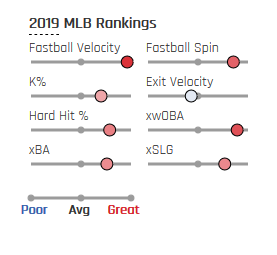
Those are indicators of an excellent reliever, but his ADP shows some skepticism of his shallow track record. Let's overlook the fact the Mets cut this guy loose so they could go throw a ton of money at Edwin Diaz and not let the Robles situation play out.
Ten closers in 2019 saved at least 20 games, converted at least 85% of their saves, with a K-BB% greater than 20%. Here are their current ADPs:
| Player | SO | SV% | SV | K-BB% | ADP |
| Kirby Yates | 101 | 93% | 41 | 36% | 84 |
| Aroldis Chapman | 85 | 88% | 37 | 26% | 89 |
| Roberto Osuna | 73 | 86% | 38 | 24% | 94 |
| Brad Hand | 84 | 87% | 34 | 27% | 122 |
| Ken Giles | 83 | 96% | 23 | 32% | 139 |
| Will Smith | 96 | 90% | 34 | 29% | 142 |
| Raisel Iglesias | 89 | 85% | 34 | 24% | 158 |
| Hansel Robles | 75 | 85% | 23 | 21% | 174 |
| Ian Kennedy | 73 | 88% | 30 | 21% | 207 |
| Felipe Vazquez | 90 | 90% | 28 | 33% | Jail |
His team's situation has improved, which should allow him more save opportunities this season. We have him projected for 25 saves, which may end up being on the low end. He's cheap on the marketplace right now, and I'm predicting him to have a Yates-like statistical breakout this year.
Oakland
Austin Allen is a top 15 catcher. Many a pixel was spent this time last year warning everyone what a dumpster fire the catcher position was going to be in 2019. I know, because I was one of them. Turns out, the kids were alright as eight catchers hit at least 20 homers and 11 catchers hit at least .250 on the season. 2020 offers more question marks as fantasy owners have to wonder whether the likes of Mitch Garver, Christian Vazquez, James McCann, Roberto Perez and Omar Narvaez can repeat behind the top-heavy class of J.T. Realmuto, Yasmani Grandal and Gary Sanchez. Needless to say, the slots behind the top tiers are rather fluid. Enter Allen.
Oakland acquired Allen as part of the deal from San Diego when they sent Jurickson Profar on a Southwest flight to San Diego. Allen played in 34 games for San Diego last year, mainly in September. Allen hit for average at every minor-league stop the past four seasons while enjoying some friendly run environments. He has also hit 20+ homers in each of the past three seasons. His defense takes a back seat to his bat, but he can throw on a first baseman's glove when needed as well. Allen had no path forward in San Diego with Austin Hedges and Francisco Mejia behind the plate and Eric Hosmer anchored at first base. The move to Oakland immediately helps because there should be a clear path to playing time. After all, this is the same org that gave Josh Phegley 342 plate appearances last year despite his terrible defense and offensive limitations.
Sean Murphy has the starting role in Oakland and is the better prospect of the two. However, Murphy has had a tough time staying healthy in recent years. He closed 2019 with meniscus surgery and had two different stints on the injured list with a strained knee in 2019. He broke his hamate bone as a junior in college in 2016, missed three weeks in 2017 with a sore hand, then later broke his other hamate bone while sliding into second base.
The opportunity should be there for Allen to showcase his offensive talents. If he can do something with that, there is a lot of profit to be made here given he is only going in 50% of NFBC drafts to date with a 681 ADP.
Chris Bassitt is a top 60 pitcher. Bassitt is currently 125th on the pitcher board with an ADP of 331 and a range from 282 to 412. He has gone in every draft, but he is going 50 picks behind the likes of Garrett Richards, who is roughly a year behind the recovery timeline Bassitt is on.
Bassitt had Tommy John surgery on April 28th, 2016, leading him to miss the rest of that season as well as the 2017 season at the major-league level. He came back to pitch 47.2 innings in 2018 before finding success last year thanks to a bit of a makeover. Early on, Bassitt struggled with command (like Darvish last year), before throwing six shutout innings in his last start before the All-Star break. Through his first 14 starts, he pitched to a 4.29 ERA and a 13 K-BB%. He closed the season with a 3.26 ERA and a stronger 19 K-BB%.
His strength is his sinker, which gets a lot of horizontal run to it, leading to weak flyball contact. That is particularly fantastic for a pitcher who pitches his home games in the most spacious foul territory this side of the Polo Ground in baseball history. It can also lead to making some of the best sluggers in baseball look like this:
Chris Bassitt's Sinker - 7.1 pic.twitter.com/cuDXRNpaGv
— Alex Fast (@AlexFast8) August 2, 2019
Remember how we all enjoyed Alex Cobb before his elbow gave out and his changeup disappeared? That's what we have here in Bassitt. He throws two different fastballs so he can change eye levels on hitters while throwing five overall pitches. Despite the bevy of pitches, he has a below-average swinging-strike rate, but had a league-average exit velocity rate in 2019.
Sean Manaea, Jesus Luzardo and Frankie Montas will get more attention on draft day, but I believe Bassitt can out-earn the entire starting staff in 2020. That trio is going somewhere between 120th and 160th overall in drafts thus far, while Bassitt is not even in the top 300. Bassitt has the home park, the team defense and the run support to be the surprise pitcher who posts a 15-win season and a sub-3.50 ERA (depending on which baseball shows up this year) like an RKO out of nowhere.
Seattle
Shed Long is a top 20 second baseman. Long is currently the 45th second baseman off the boards in NFBC drafts with an ADP of 459 and a range of 324 to 583. He has gone undrafted in three drafts to date. Let's face it: Seattle is going to be a terrible team this year. While the rest of the division is getting stronger, they've done nothing to improve the team and are likely to move more assets in the coming months.
Long currently does not have a starting position in Seattle. He can play both second base and outfield (and even caught in high school and early in MiLB career!), but those spots are currently manned by Dee Gordon, and the trio of Kyle Lewis, Mallex Smith and Mitch Haniger. The hope for Long is his positional flexibility keeps him around until someone is traded (Gordon, Smith), or flops (Lewis). Long didn't embarrass himself in his rookie season putting up a 111 wRC+ over 168 plate appearances. He was in the big leagues before his 24th birthday and already has 418 plate appearances above Double-A ball. The Mariners organization has not allowed him to run as frequently as he ran with the Cincinnati organization, but Long has performed well despite being one of the youngest players in both Triple-A and the big leagues.
Scouting reports grade Long with slightly above average offensive tools across the board, and he has enough power to go oppo in places like Safeco Field as he did last year. Seattle has nothing much to play for in 2020 but the future, and Long is a part of their future. He may not have a starting job on Opening Day, but once an opportunity is created for him, the only reason for him to lose it would be by his own accord. Nick Madrigal is going nearly 200 spots in front of Long so far in drafts, but Long has an easier path to 450 plate appearances this season. Long has 418 plate appearances above Double-A while Madrigal has just 134. The White Sox are clearly making a 2020 push signing veterans and acquiring more hitting as Cleveland is deciding to save their money and sell off assets.
Justus Sheffield earns $5 in AL-Only formats. I made this same prediction for Erik Swanson last year, and it failed. I wanted to do this same prediction last year with Sheffield, but thought he was too young and needed more experience. He got the experience alright; pitching in Triple-A Tacoma in the PCL was a tough lesson for him as he he compounded home run issues with a high walk rate and pitched to a 2-6 record with a 6.87 ERA. This is where having a short memory comes into play.
The scouting report on Sheffield heading into last season gave his fastball and slider 55 grades, and his changeup a 50 grade on the 20-80 scale, giving him three above-average (45) pitches when all is working right. Baseball America rated him as the top prospect in the Seattle system, and gave him an overall grade of 60 on the 20-80 scale. His slider is the best pitch right now for him and it's the one he uses to get his strikeouts. He has good fastball velocity and even better movement with it. The spin rate on his four-seamer is in the first percentile, so the pitch has a lot of vertical drop; the league average is 17 inches and his drops 22 inches. His command grade was right at league average, and the pitcher was clearly shell-shocked last year with the new baseball and the launching pad environments of the Pacific Coast League.
Despite the work in progress, Sheffield still struck out 22% of the hitters he faced last season, which speaks to his potential. He needs the changeup to come along to do better against righties as they absolutely torched him last year in his time in the majors (.328/.395/.500), and that will be key to watch for him while he works in the Cactus League this spring. His ADP sits at 399 with a range between 341 and 500, but he has been drafted in all 42 drafts to date. You do not need to reach for him as he is the 149th pitcher off the board, but there is potential here for him to return a profit on a reserve round pick if his actual command and changeup match his projections.
Texas
Nick Solak earns $15+ value in mixed leagues. Solak has played in three organizations in three years, first with the Yankees, then Tampa Bay, and now the Rangers. Solak has hit wherever he has played and has a .294/.383/.468 triple-slash line to show for his minor-league career and a .346/.442/.484 triple-slash for his collegiate career at Louisville. The bat isn't the problem; it's his defense. Solak does not have a true defensive home because the overall defensive skills package is below average and if you don't defend well in Tampa Bay, they find another place for you. Between Triple-A Durham, Triple-A Nashville and Texas, Solak hit 32 homers last year and drove in 91 runs. He is an above-average runner with a sold hit tool and slightly-above-average power which he fully utilized in 2019 to pound the happy fun ball into submission.
The Rangers plan on using Solak at third base next year despite the defensive issues, and this is the major risk with this prediction. Solak can stay on the position as long as he hits because the Rangers clearly want the bat in the lineup. If Solak's defensive limitations are magnified at the hot corner, and the defensive struggles carry over to the plate, this could all fall apart quickly. The other problem with Solak on draft day is that he is only eligible at Utility in most league formats. The benefit there is if you throw him out early in the auction, you could save some money as many owners are hesitant to fill that roster spot early in an auction and lose the flexibility to move players around during the auction. Solak's offensive skills are worth the play, so the bigger the discount, the better return on investment for you as long as the glove is at least serviceable at the hot corner. He can "play" second base and the outfield as well, so there are other options if the Texas depth chart needs help.
Corey Kluber earns below $20 in standard mixed leagues. Last year was an abbreviated season for Kluber as he made seven starts and was wildly unprofitable. The five seasons before that saw Kluber earn $34, $21, $32, $47, and $35. While the prediction may seem a bit easy against the $21 he earned in 2015, but over that five-season span, Kluber's average mixed league value was $34. I'm concerned for 2020.
The average fastball velocity on his four-seamer is in a six-year decline from 94.6 in 2014 to 92.4 this past season. That is the normal aging curve, but Kluber's fastball velocity was in the lowest 20th percentile of the league last year. Before the broken arm which ended his season, Kluber did not look good with a pedestrian (especially for him) 14 K-BB% while the league hit .293 against him along with a 1.65 WHIP and 5.80 ERA (4.06 FIP).
The slider has always been Kluber's best pitch as it has had ridiculous pitch values in his full seasons, ranging from 15.5 to 37.0. At his peak, that slider had a swinging-strike percentage in the mid-to-upper 20s, but it made it to 20% in 2018 by rounding up the decimal, while it finished last year at 19.3%. Over the past four seasons, the whiffiness on the slider has gone from 28%-28%-20%-19.3% and over that time, opponents' batting average against it has gone .099-.101-.104, and .176 last year. That is concerning.
Kluber has a current ADP of 88 with a range from 61 to 108. He is going in front of the likes of James Paxton, Brandon Woodruff, Jose Berrios, Sonny Gray, Mike Soroka and Hyun-Jin Ryu, and 30 picks in front of his left-handed twin brother Madison Bumgarner. Bumgarner returned from an injury-plagued 2017 and 2018 time, but finished 2019 at $15. His previous five-season run from 2012-2016 was never below $20 and he averaged $26 earned. The drop into the teens is what I believe will happen with Kluber this year as well given both pitchers face similar issues with declining effectiveness of their best pitch. Kluber should be good, but the group is drafting him as a top 30 pitcher, and I believe there will be many disappointed owners by season's end.







